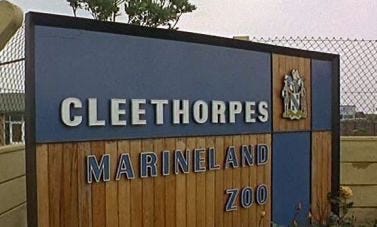By 1978, Cleethorpes was looking especially tired. I don’t recall any new council or privately financed initiatives starting up around that time, designed to lure fresh visitors. The only changes to the sea front that I noticed were new graffiti and acts of vandalism. The bathing pool, which had been a popular fixture in the resort since 1925, had suffered damage in the Winter storms of January 1976, and exactly two years later even worse gales and flooding finally put paid to it. This was less fin de siecle, more ‘fag end’.
Another major attraction that ran into difficulties around this time was Cleethorpes Marineland Zoo. It had been operating on a fairly large site off King’s Road, between the boating lake and the Humberston area of the town since the mid-Sixties. I was taken to it a number of times in my earlier childhood, and even by the early Seventies it had already developed an air of neglect. None of it was kept particularly neat and clean. The less said about the customer cafe, the better. The animals were often very hard to spot in their cramped enclosures, preferring to huddle together in whatever small interior spaces they could find. So, typically a visit would be a repeating process of trying to spot this or that creature. I can still hear the distant echo of parents, and their children, exclaiming ‘well, I can’t see it’. You felt lucky if you saw a passing sparrow taking a dust bath at the side of one of the zoo’s poorly maintained paths.
In its heyday, if it ever had one, the venue ‘boasted’ of its collection of big cats and other large mammals, none of which, as is now widely agreed, should have been anywhere near this kind of inadequate captivity. And then there were the performing dolphins, and the poor orca called Calypso, an apex predator reduced to a glorified bathtub of a pool space to lose its high-functioning mind in. There was a lone Indian elephant by the name of Tanya, whose eyes betrayed a sadness for the ages and who once made the local press for ‘accidentally’ crushing her keeper inside the pachyderm house, an interior concrete area that would not have looked out of place at Abu Ghraib. Indeed, ‘prisoners’ would be an appositive term to describe pretty much every type of life form to be found within the perimeter fence that encircled the zoo. Even when I was young, seeing all of this animal suffering, I was left with the overwhelming thought that the kindest thing to do to these poor beasts would be to shoot them all dead and put them out of their misery. More on that shortly.



